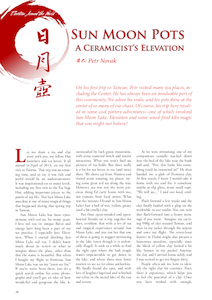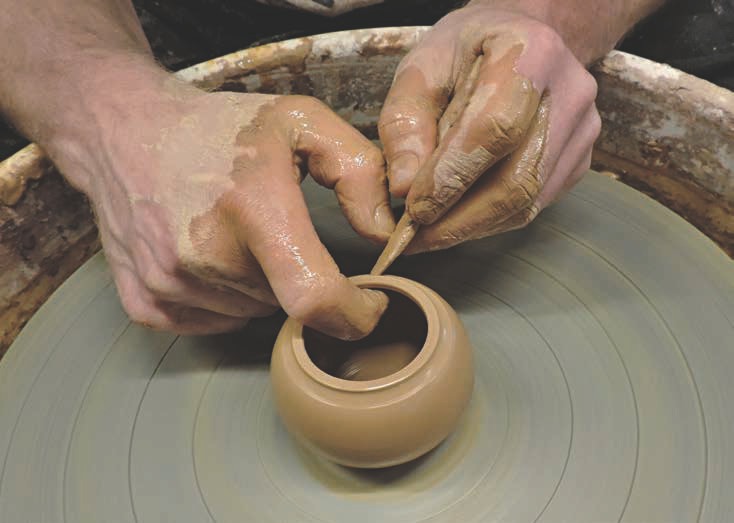
 |
|
Let me share a tea and clay story with you, my fellow Hut members and tea lovers. It all started in April of 2014, on my first visit to Taiwan. That trip was an amazing time, and to say it was rich and joyful would be an understatement. It was inspirational on so many levels, including my first visit to the Tea Sage Hut, adding important pieces to the puzzle of my life. This Sun Moon Lake anecdote is one of many magical things that happened during that spring trip in Taiwan.

Sun Moon Lake has been synonymous with red tea for many years. I love red tea; its unique flavor and energy have long been a part of my tea practice. I especially love Elevation. When I started drinking Sun Moon Lake red tea, I didn't know much about its terroir or what to imagine about the place, other than that the name is beautiful. But when I bought my flight to Formosa, Sun Moon Lake was on my "must-see list." If you've never been there, just do a quick search online for some photographs and you'll get an idea of how wonderful and gorgeous the lake is, surrounded by lush green mountains, with some scattered hotels and tourist attractions. What you won't find are pictures of tea fields. But there really is a lot for tea lovers to see (and taste) there. We drove up from Nantou and visited some amazing tea places, trying some great red tea along the way. However, tea was not the most precious thing I'd carry home with me, nor teaware from local artists. What was the treasure I found in Sun Moon Lake? Just a ball of wet, yellow, greasy (and a bit smelly) clay.
Put three open-minded and openhearted friends on a trip together for days, combine that with a lot of tea and magical experiences around Sun Moon Lake, and you can bet that one of them is going to suggest swimming in the lake (even though it is technically illegal). It took us a while to find the right spot where the lush jungle wasn't impenetrable to get down to the lake, and where there were fewer tourists to see us, let alone authorities. We finally found the spot, and with lots of laughter baptized and refreshed our selves in the sacred lake of the sun and moon.
As we were swimming, one of my companions casually reached down into the bed of the lake near the bank and said, "Petr, this looks like something you'd be interested in!" He then handed me a glob of Formosa clay. At first touch, I knew I would take it home with me and fire it somehow, maybe as slip glaze, some small cups. "We will see..." I said out loud, smiling.
Flash forward a few weeks and the clay finally landed with a plop on the worktable in our studio. You can turn that flash-forward into a funny montage if you want: Imagine me carrying 900g of clay around Taiwan, and then in my jacket through the airport and onto my flight. The seven-hour layover in Dubai might also present a humorous anecdote, especially since the block of yellow clay looked a lot like Semtex in my pocket! Anyway, the clay and I arrived home safely, and I was excited to get my fingers dirty.
People often ask me how to identify the right clay for ceramics. First, there is experience, which helps you to feel the potential of a clay. Once you have worked with enough, you'll know if a natural clay is right. You can check the plasticity and structure. You can see color and smell how clean the material is. But there is always some guesswork and experimentation, too. In the end, you have to test and try clays. You will also have to see if your technique is suitable for the material you've found. Finally, a clay has to go through the fire so you can determine what temperature it can handle - what firing is ideal for that particular clay.
As many of you probably know, clays vary in many ways. Even laypeople can tell the difference in color, texture and plasticity of clay bodies. The basic question that every potter wants to answer to is what temperature and what firing schedule fits the clay. There are clays that are fired to 1000°C, and with some you cannot go higher at all. And then there are stoneware and porcelain bodies that are fired to more than 1400°C to get the best results. If the clay I brought from Sun Moon Lake were for low fire, then I could use it as a slip-glaze. But if it could stand at least 1250°C, I could make some actual teaware out of it, rather than just glazing some other pieces with it.
So first things first, I had to make a few test cones and put them into the wood-fired kiln to see what would happen. Such cones, laid out around the kiln, can tell us a lot about any new clay. These samples show the color variations, texture and, as I mentioned before, the clay's response to reduction firing at different temperatures (our wood-fired kiln varies between 1230-1380°C, depending on the position in the kiln and the wood used to fire). After this first firing, I was pretty sure. The Sun Moon Lake clay was right on the edge, but there was a good chance that it could survive the coolest edges of our kiln. Exciting!
I thought about it for some time, as the clay was precious to me, and finally decided to take the leap and forgo using it as a slip-glaze, making teaware instead. I had thought to make some nice cups, but changed my mind. Why not take a chance and make some teapots from my Sun Moon Lake mud? Since there were three of us swimming that day, and it was thanks to the help of a fourth friend that we were able to make the whole trip to Sun Moon Lake with such ease in the first place, I decided to divide the clay into four teapots from bottom of Sun Moon Lake, creating souvenirs you'd never find in any of the hundreds of gift shops there.

I decided to work with this clay as I am accustomed to with all of our clays, but with a small and very important difference: Usually, when we try our hands at such "wild" clays, we clean them first, straining out all the rough, larger materials from the clay. The best way to do this is to mix the clay with water, kneading it into a thin paste, and then sieving the slip, separating the rougher bits. Then, we wait till the sieved slip dries and wedge it well, letting it rest for some time (the longer the better). However, this time, I chose not to sieve the clay, leaving it as natural and rough as the day my friend lifted it out of the lake smiling. Despite the grainy roughness, the clay was very nice to work with, which was actually quite surprising. I'd thought it was going to be much more difficult to throw. Still, the bigger stones in the clay made throwing the pots on the wheel and finishing them a bit of a challenge, but the clay was plastic and strong, and that allowed me to pinch quite thin walls, spouts and handles without feeling like the pots were too fragile. To make the pots safer for the final wood-firing, I bisque-fired them first to 1000°C. As with all pots, after the bisque fire, there was more cleaning, final corrections and polishing to do. We have literally fired hundreds of kilns, and yet there is not a single firing that is without surprise. We love experimentation and always add at least a small test of new glazes into every firing, be it new clay or glaze combinations. There is always a revelation waiting for us when we open a kiln.
Our wood kiln is considered a "fast fire kiln." We fire from between sixteen to twenty hours, which means the kiln cools down enough that it is safe to unload after three days. The days of waiting, resting and cleaning our studio are always slightly tense and exciting, filled with anticipation for what's inside. The summer firing of 2014 held one such surprise, and one that we looked on with big smiles: four sound, whole and glorious Sun Moon Lake teapots for four friends!
The resulting Sun Moon Lake teapots are very interesting. The color and texture of their bodies and the feel of the clay is incredible. Because I did not clean the clay, the pots are scattered with small stones, which give texture and character to these small pots. The small stones were obstacles during the throwing and finishing, but I knew they would become essential. The pots wouldn't be the same without them - they'd lose their rustic touch. They really are unique teapots. And, of course, you know which pot I am going to use to brew this month's Elevation!


I thought about it for some time, as the clay was precious to me, and finally decided to take the leap and to forgo using it as a slip-glaze, making teaware instead. I decided to work with this clay as I am accustomed to with all of our clays. However, this time, I choose not to sieve the clay, leaving it as natural and rough as the day my friend lifted it out of the lake smiling.
